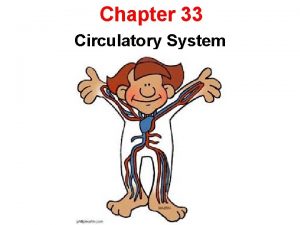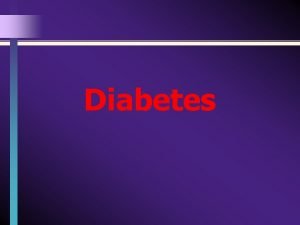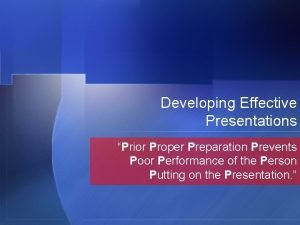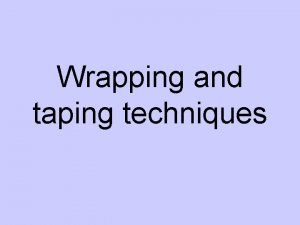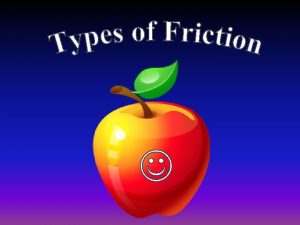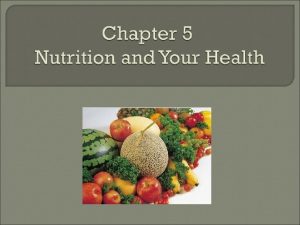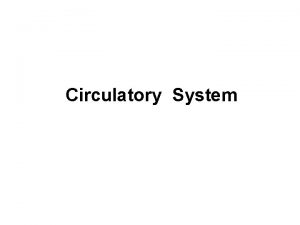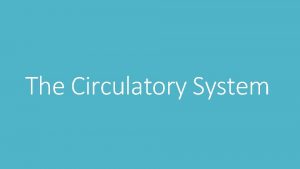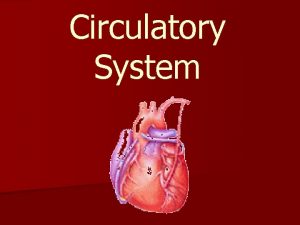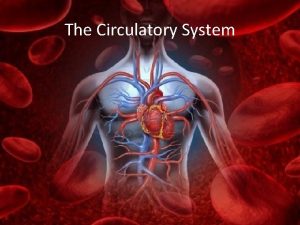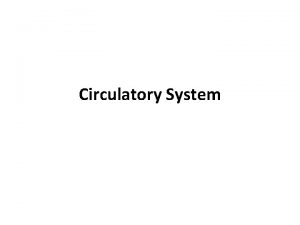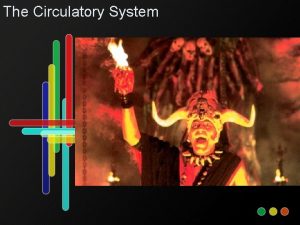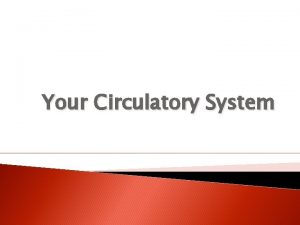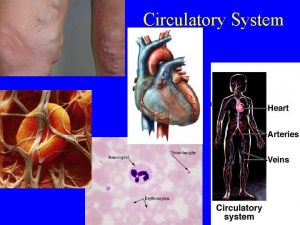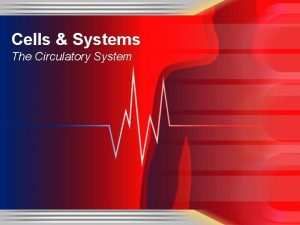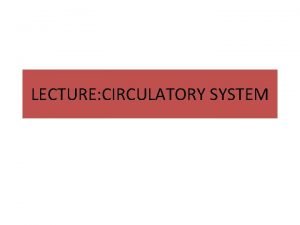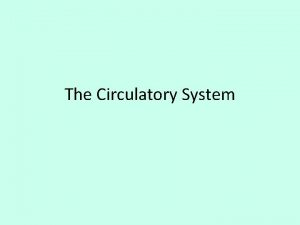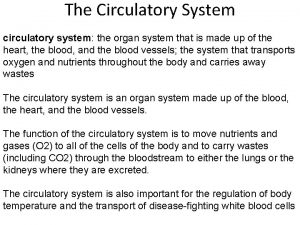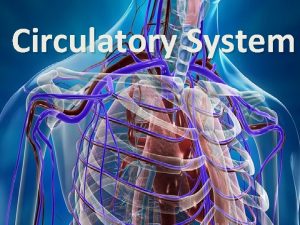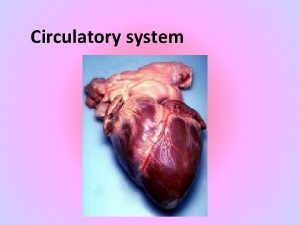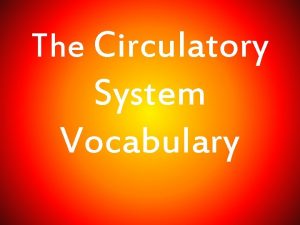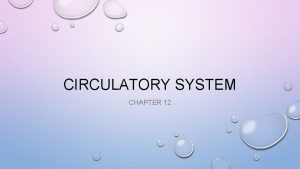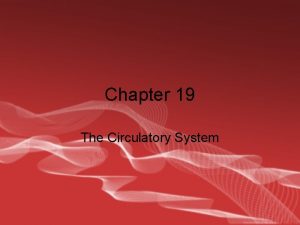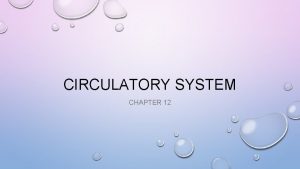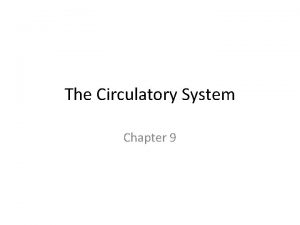Circulatory system Chapter 7 Circulatory system PREVENTS CELLS



























- Slides: 27

Circulatory system Chapter 7

Circulatory system PREVENTS CELLS FROM SUFFOCATING l BRINGS CELLS OXYGEN AND NUTRIENTS l Also called the cardiovascular system l


PATHWAYS HEART- PUMPS BLOOD ARTERIES- CARRY BLOOD AWAY FROM THE HEART VEINS- CARRY BLOOD TOWARD THE HEART CAPILLARIES- TINY VESSELS THAT REACH SINGLE CELLS- THE SITE WHERE EXCHANGE OCCURS

ARTERIES WALL- have 3 LAYERS l INNER- simple squamous epithelium + connective tissue= endothelium l Middle- smooth muscle l Outer- loose and fibrous connective tissue Arterioles- tiny arteries

Capillaries Nourish individual cells l can be closed when muscles in precapillary sphincter are contracted l an arteriovenous shunt is a vessel allows the blood to bypass the capillaries and move on to a venule while the precapillary sphincter is closed l

Veins Venules- tiny veins that drain capillary beds l 3 layers, but less muscle and connective tissue l Have one way valves to prevent blood from staying in the legs l Vein walls can expand- 70% of all the blood is in the veins l



Heart Cone shaped, fist sized l Myocardium- the cardiac muscle l Pericardium- the thick sac around the heart l Septum- the internal wall that separates the right and left halves l Upper 2 chambers- atria l Lower 2 - ventricles l

Valves Chordae tendineae- strings that prevent one way valves from opening backwards l Atrioventricular valves- separate upper and lower chambers Right- tricuspid Left- bicuspid or mitral l Semilumar valves- downstream of ventricles pulmonary- right aortic- left l


Major vessels Right half source of blood- from superior and inferior vena cavae l Right blood output- to Pulmonary arteries l Left blood input- from pulmonary veins l Left output- to Aorta l

HEART RIGHT SIDE- PUMPS OXYGEN POOR BLOOD FROM BODY (VENA CAVA) TO LUNGS (PULMONARY ARTERY) LEFT SIDE- PUMPS OXYGEN RICH BLOOD FROM LUNGS (PULMONARY VEIN) TO THE REST OF THE BODY (AORTA) l The Left side works harder


Cardiac cycle l l l l Systole- period of muscle contraction Diastole- resting period Lub dub- sound of heart valves slamming shut Murmur- caused by leaky valves SA node- the heart’s pacemaker- located on the right atrium, creates the electrical impulse AV node- below right atrium- electrical impulse passes through on its way to. Perkinje fibers- conducts the impulses to the muscle cells that cause contraction of ventricles

Control of heart rate Medulla oblongata- nerve impulses from brain stem l Endocrine hormones from adrenal glands- epinephrine and nor epinephrine l l Defibrillation- an electrical shock to reestablish ventricular rhythm given to persons with heart problems

HEART ATTACK BLOCKAGE OF A CORONARY ARTERY which supplies the heart muscle with oxygen and nutrients l PART TO HEART MUSCLE SUFFOCATES l IF ENOUGH MUSCLE TISSUE STOPS WORKING THEN THE HEART CAN’T PUMP BLOOD (massive heart attack) l

Other Problems/Treatments Aneurysm- ballooning of weakened artery, can burst and cause massive internal bleeding Treatments for clogged vessels l Nitroglycerine- dilates blood vessels l Clot dissolving drugs- to treat heart attack l Angioplasty- balloon inflated inside a partially clogged artery to expand it l



BLOOD PRESSURE THE FORCE THAT BLOOD EXERTS AGAINST THE WALLS OF OUR BLOOD VESSELS l CONTRACTION OF VENTRICLES= HIGH PRESSURE- SYSTOLE l PRESSURE DROPS MOMENTARILYwhen the heart relaxes- DIASTOLE l

BLOOD PRESSURE SYSTOLE/DIASTOLE l MEASURED WITH A STETHOSCOPE AND PRESSURIZED CUFF l CUFF CUTS OFF BLOOD AT A HIGH ENOUGH PRESSURE l SYSTOLIC- 110 -140 = NORMAL l BELOW 100 - LOW l HYPERTENSION- 140/90 or greater l



Other Problems Hypertension= High blood pressure l Atheriosclerosis- cholesterol under endothelium of arteries l Blood clots may form on the irregular artery walls l Thrombus- attached clot- embolus- free clot which is moving through the vessels l Stroke- burst or blockage of brain arteriole l

Veins Weak one way valves- causes swelled veins (spider veins and varicose veinsusually in the legs/feet) Hemorrhoids- swelled veins of rectum Phlebitis- inflammation of veins l
 Nondisjunction in meiosis
Nondisjunction in meiosis Digestive system circulatory system and respiratory system
Digestive system circulatory system and respiratory system Pns water view position
Pns water view position Tubular reabsorption
Tubular reabsorption Parafollicular cells vs follicular cells
Parafollicular cells vs follicular cells Gamete vs somatic cell
Gamete vs somatic cell Somatic vs germ cells
Somatic vs germ cells Chlorocruorin
Chlorocruorin Prokaryotic vs eukaryotic transcription worksheet
Prokaryotic vs eukaryotic transcription worksheet Plant and animal cell venn diagram
Plant and animal cell venn diagram Prokaryotic cells
Prokaryotic cells Why did robert hooke name cells “cells”?
Why did robert hooke name cells “cells”? Masses of cells form and steal nutrients from healthy cells
Masses of cells form and steal nutrients from healthy cells Pseudostratified vs simple columnar
Pseudostratified vs simple columnar What cell type
What cell type Prokaryotic cells vs eukaryotic cells
Prokaryotic cells vs eukaryotic cells Cell substance
Cell substance Chapter 34 circulation in humans concept mapping answer key
Chapter 34 circulation in humans concept mapping answer key Capillary bed labeled
Capillary bed labeled Chapter 33 section 1 the circulatory system
Chapter 33 section 1 the circulatory system How respiratory system work with circulatory system
How respiratory system work with circulatory system Circulatory system and respiratory system work together
Circulatory system and respiratory system work together It is a disease that prevents the body from converting
It is a disease that prevents the body from converting Proper preparation prevents poor performance
Proper preparation prevents poor performance Kinesio tape: thumb hyperextension
Kinesio tape: thumb hyperextension Monopoly cost and revenue diagram
Monopoly cost and revenue diagram What type of friction prevents an object from moving?
What type of friction prevents an object from moving? Chapter 5 nutrition guidelines tools for healthful eating
Chapter 5 nutrition guidelines tools for healthful eating



















